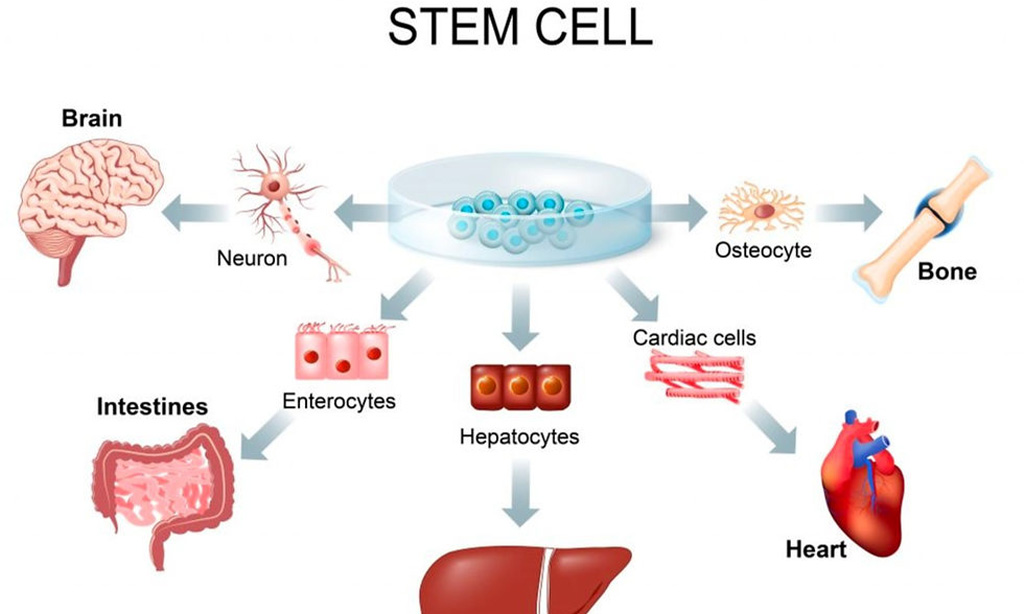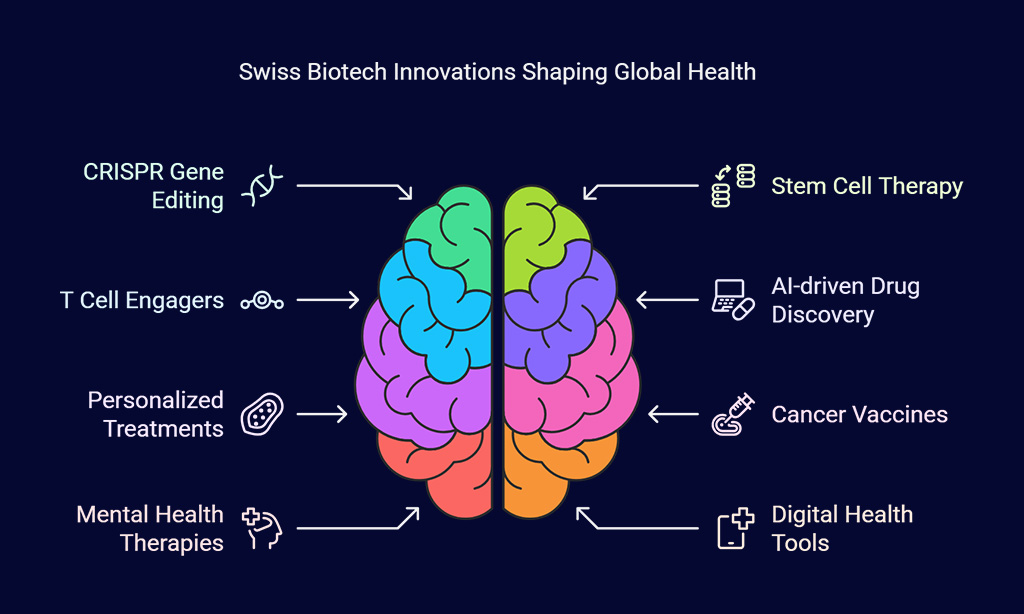Researchers across the globe put their optimum efforts to discover revolutionary methods to combat illnesses. Particularly in Switzerland, a dynamic biotech sector intensifies this endeavor.
The local enterprises and scientific explorers in the country are on the forefront of fabricating treatments that have the potential to transform the healthcare sector by 2030.
Swiss Biotech Breakthroughs hold potential to facilitate disease cures in the near future. This piece elaborates on the progression of gene editing, stem cells, cancer therapies, intelligent drug discovery, and individualized treatments.
These advancements might steer us all to a future characterized by better health by 2030.
Switzerland: A Global Hub for Biotech Innovation
Switzerland is a key player in the biotech industry. It hosts major companies and research institutions like Novartis and Roche. These entities lead efforts in drug discovery and clinical trials.
According to the Swiss Biotech Report 2022, biotech advancements could allow for the cure of up to 45% of all diseases soon. This highlights Switzerland’s critical role in developing new treatments.
The country invests heavily in disease research and development. With government support, Switzerland aims to improve science and technology continuously. This investment aids both startups and established companies in creating medicines that can save lives.
Projects range from cancer therapies to gene editing with CRISPR tools, aiming to revolutionize medicine by 2030.
Breakthrough 1: CRISPR Gene Editing for Precise DNA Modification
CRISPR gene editing changes DNA with high precision. It cuts and repairs DNA parts causing diseases. This method is more efficient and less costly, enhancing trial speed for new treatments.
AC BioScience employed CRISPR for colorectal cancer research. They demonstrated that precise DNA edits could halt cancer cell growth. This advancement paves the way for targeted treatments against various severe diseases by focusing on genetic roots.
Breakthrough 2: Regenerative Medicine Using Stem Cells and Tissue Engineering
Swiss scientists are advancing in regenerative medicines. They use stem cells to create tissues, aiming to repair body parts damaged by injury or disease. This approach uses a person’s own cells, reducing risk of rejection and side effects.
Doctors might soon heal previously untreatable injuries or diseases. For instance, they can regenerate heart tissue or mend bones using this technology. Scientists grow these special cells into needed tissues in the lab.
Then, they implant them back into the patient’s body where needed for natural and faster organ repair, like liver or skin healing.
Breakthrough 3: T Cell Engagers for Cancer and Autoimmune Diseases
T cell engagers are revolutionizing cancer and autoimmune disease treatment by improving how the immune system attacks diseased cells. In Switzerland, researchers aim to leverage biotechnology to treat up to 45% of diseases by 2030, with T cell engagers playing a key role.
This method stands out because it links two targets: one on the sick cell and another on a T cell. This precision guides the immune system directly to the problematic cells. Swiss scientists lead in merging this knowledge with ongoing research efforts.
Through continued studies and trials, these innovative therapies promise extended and healthier lives for many.
Breakthrough 4: AI and Data-Driven Drug Discovery
Switzerland uses AI and big data to speed up drug discovery. Computers analyze health records and research to find patterns for new treatments. This helps scientists test promising ideas faster.
AI supports scientists in finding drugs at unprecedented speeds.
Swiss companies use AI to identify effective drugs for cancers or rare diseases quickly, avoiding long trial periods. This technology sifts through medical information fast, finding new ways to use precision medicine and gene therapies that were hard to think of a decade ago.
As a result, patients might get new treatments sooner, improving lives worldwide.
Breakthrough 5: 3D Organoids for Testing and Personalized Treatment
Physicians are currently utilizing 3D organoids, small models of human organs, to examine medications. This technique aids in determining the suitable therapy for individuals by anticipating their possible bodily reactions.
The formation of 3D organoids signifies advancement in disease therapy.
Such a method accelerates the process of drug examination. Previously, exams required either animal or human subjects. Presently, these miniature organs provide defined outcomes without involving those stages.
This breakthrough paves the way for customized therapies fit to the unique requirements of individuals.
The Role of Swiss Biotech Companies in Advancing Healthcare
Swiss biotech firms lead in healthcare by using CRISPR and analytics for faster drug development, targeting diseases more effectively.
Novartis and Roche: Leading the Way
Novartis and Roche have their roots in Switzerland. They are engaged in the development of drugs for cancer, heart conditions, and eye diseases. Leveraging advanced technology, such as data analysis, these companies accelerate drug development.
They emphasize individualized treatments for patients.
They commit a significant portion of their resources to research to upgrade disease treatment worldwide. Their innovations equip physicians to formulate specific treatment agendas for their patients.
Emerging Startups Driving Innovation
Swiss startups are transforming the biotech industry. AC BioScience creates new treatments for colorectal cancer from Biopôle, showing how small teams can make significant impacts.
Their innovation could generate $5 billion by 2030 as it offers safer and more effective options compared to traditional therapies.
Cinainu also stands out by tackling severe illnesses with advanced techniques. These companies benefit from support by the Swiss Biotech Association, leveraging cutting-edge technologies like gene editing and stem cells.
Their efforts aim to revolutionize disease treatment by 2030.
Benefits of These Breakthroughs for Global Health by 2030
Swiss biotech breakthroughs are shaping the future of global health. Their impact by 2030 could change how we treat many diseases.
- New treatments from CRISPR gene editing will make DNA changes to stop diseases like sickle cell anemia. This will help countless people live better lives.
- Using stem cells, doctors can grow new tissues for patients. This means organs that were once damaged can heal or even be replaced.
- Cancer and autoimmune diseases will meet their match with T cell engagers. These smart cells target and kill diseased cells without harming healthy ones.
- AI-driven drug discovery will speed up the creation of new medicines. With computers helping, scientists can find cures faster than ever before.
- Personalized treatments become the norm, thanks to 3D organoids that mimic human organs for testing drugs. Each person gets medicine just right for them.
- Novartis and Roche, leading Swiss companies, will bring more safe and effective cancer vaccines to market, targeting tumors directly.
- The federal master plan boosts research, leading to breakthroughs in mental health disorders such as PTSD and depression with novel therapies.
- With digital health tools like electronic health records and telemedicine, doctors can reach patients anywhere, anytime—improving care globally.
- Swiss startups are on the rise, creating jobs and pushing pharma trends forward with innovative solutions in disease prevention and management.
Each of these benefits points to a healthier world by 2030, thanks to Swiss biotech innovations.
Challenges and Opportunities in Biotech Development
Creating biotech drugs and treatments is challenging but rewarding. Developing new medicines involves extensive testing, including phase I, phase II, and phase III trials. These processes are expensive and time-consuming.
However, progress in immunology opens doors to innovative cancer treatments. Research on T-cells’ role in attacking tumors enhances cancer therapy options. The Internet of Medical Things [IoMT] allows for real-time health monitoring, enabling personalized treatments based on precise data.
Companies like Novartis and Roche use AI to discover drugs more efficiently, reducing research costs. This approach may lead to job creation and influence global healthcare trends by 2025.
Despite the difficulties posed by compliance and safety regulations, the potential to cure diseases by 2030 and achieve sustainable raw material usage is significant.
The Future of Swiss Biotech: A Vision for 2030
Swiss biotech aims to cure up to 45% of all diseases by 2030 with advanced research. Novartis and Roche lead this effort, improving how drugs fight cancer and other major illnesses.
New startups bring innovative approaches frequently.
Technologies like CRISPR allow for precise gene editing, while AI accelerates new drug discovery. Personalized treatments become more common as knowledge about body responses to illness expands.
Insights into immune systems lead to therapies that enhance our natural disease-fighting capabilities.
By 2030, expect significant advancements in medical treatments worldwide.
Takeaways
Switzerland’s biotech industry is standing out, thanks to experts like Dr. Lena Horowitz. With years of experience and many projects under her belt, she has deep knowledge in using modern science to fight diseases.
Dr. Horowitz points out five key advances in Swiss biotech: gene editing, cell therapy, new cancer treatments, drug discovery through computer models, and organ-on-a-chip technology for testing drugs.
Safety is a major focus for her. These innovations must be safe for patients and comply with regulations. Clear communication with patients is essential.
She advises careful consideration before these technologies become everyday solutions. They offer great benefits but need proper application.
Dr. Horowitz compares these advancements against other available treatments discussing their speed, cost-effectiveness, durability, and efficiency.
By 2030, Dr. Horowitz sees these biotech breakthroughs significantly improving health care and disease treatment methods.
FAQs
1. What are some of the breakthroughs in the Swiss biotech industry that could cure diseases by 2030?
The Swiss biotech industry is working on several promising drug candidates, including antibody-drug conjugates for cancer treatment and antisense oligonucleotides to regulate gene expression. They’re also exploring treatments for retinitis pigmentosa and age-related macular degeneration.
2. How might these breakthroughs improve personalized treatment options?
These developments aim to boost personalised treatments by focusing on immune responses, with a particular emphasis on natural killer cells and major histocompatibility complex molecules. The goal is to tailor therapies based on individual’s unique genetic makeup and disease profile.
3. Are there any specific diseases these breakthroughs target?
Yes indeed! For instance, trastuzumab deruxtecan targets breast cancers while anti-PD-1 drugs focus on various types of tumors. Also, research into glutamate receptor modulation could lead to new treatments for mental health disorders like post-traumatic stress disorder.
4. Can you explain how antibody-drug conjugates work in cancer treatment?
Sure! Antibody-drug conjugates [ADCs] combine an antibody – which can locate cancer cells – with a chemotherapy drug designed to kill those cells once located. This allows more targeted delivery of chemotherapy drugs, reducing damage to healthy tissues.
5. How does the circular economy fit into this picture?
In a bid towards sustainability, many companies are adopting principles of the circular economy in their corporate strategy – this includes waste reduction strategies and sustainable procurement practices within their supply chain.
6. What role do phase 2 studies play in these breakthroughs?
Phase 2 studies are crucial as they test whether potential drug candidates are effective against certain conditions or illnesses among larger groups before moving onto Phase 3 trials which further evaluate efficacy and monitor side effects.









































